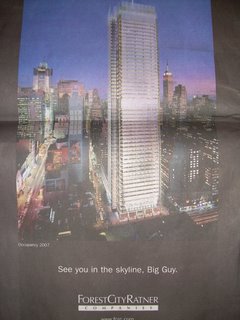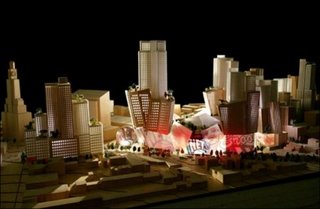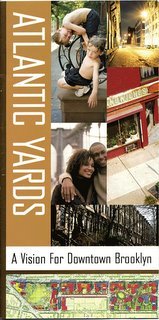 In the June issue of Editor & Publisher, the monthly trade journal of the newspaper industry, "Ethics Corner" columnist Allan Wolper takes a look at the New York Times's dicey relationship with Forest City Ratner. The headline: 'NY Times' Coverage Hits Close To Home, with the subhead: Reporters challenged to objectively cover dealings of a real estate company directly involved with New York Times Co.
In the June issue of Editor & Publisher, the monthly trade journal of the newspaper industry, "Ethics Corner" columnist Allan Wolper takes a look at the New York Times's dicey relationship with Forest City Ratner. The headline: 'NY Times' Coverage Hits Close To Home, with the subhead: Reporters challenged to objectively cover dealings of a real estate company directly involved with New York Times Co. In barely 800 words, the column must skip over a lot of ground, and doesn't attempt to assess the Times's overall performance. (A longer version should be posted on the E&P web site, but not for at least a week.) Though I take issue with several shadings in the story and point out areas for closer analysis, the column makes two important points:
- though the Times Company has guaranteed a loan to Forest City Ratner, the newspaper doesn't disclose that loan in articles about the developer, and it should
- rival dailies had been stymied in getting Forest City Ratner to waive a gag order on people who sold their apartments to the developer, but only for the Times was the gag lifted.
Wolper's conclusion: it’s "dangerous for the paper to go into business with corporations they are supposed to be monitoring." While this is a worthwhile first step in raising the issue nationally, for those of us who look at the relationship closely, it's even more dangerous than his column lets on.
No-win situation?
 The column begins by setting up the real estate deal between the New York Times Company and Forest City Ratner to build the new Times Tower in 2000, and then how the Times began covering the Atlantic Yards project. Wolper notes:
The column begins by setting up the real estate deal between the New York Times Company and Forest City Ratner to build the new Times Tower in 2000, and then how the Times began covering the Atlantic Yards project. Wolper notes:If that wasn't messy enough, the New York Times Co. Annual Commitment and Liability report notes the company is obligated to loan Forest City $119.5 million to finish the latter's share of the building if the real estate company can't come up with the money on its own.
It's obvious that the Times would want Forest City Ratner to make its Brooklyn project a financial success so that it won't have to ask the newspaper company to come up with the loan.
By the same token, he notes, reporters shouldn’t feel pressure either way to slant the news.
 It's not just that the Times Company wants the Atlantic Yards project--a name unmentioned in this column--to be successful. The Times Company wants the Times Tower to be successful and the newspaper, even before the Atlantic Yards project was announced, provided inadequate coverage, while the New York Observer and the Village Voice have looked much more closely.
It's not just that the Times Company wants the Atlantic Yards project--a name unmentioned in this column--to be successful. The Times Company wants the Times Tower to be successful and the newspaper, even before the Atlantic Yards project was announced, provided inadequate coverage, while the New York Observer and the Village Voice have looked much more closely.The loan has been mentioned in only one previous article about the project, and not in the Times. As noted in Afterword B of my report, a 10/28/03 article in the New York Post (Liberty Bonds Key To Ratner) explained that the Times would “guarantee” up to $100 million of the loan that Ratner needs to construct the tower’s top half.
Is disclosure all?
The column continues by quoting a Times Company spokesman on the policy of disclosure in articles, press releases, and the annual report. But Wolper finds a flaw, saying that the disclosure is insufficient:
Even though every Times news story on the subject includes a line identifying Forest City Ratner and the Times Co. as co-developers of the Manhattan midtown tower, there are no references to the loan agreement.
Every Times news story? The Times has been mostly scrupulous of late in disclosing the relationship; however, as noted in Chapter 10 of my report, several articles about the Atlantic Yards project, or about Forest City Ratner projects, have lacked the disclosure. One notable example: architecture critic Herbert Muschamp's 12/11/03 rave review, which also lacked an acknowledgement that Muschamp served on a committee with Forest City Ratner officials to choose an architect for the Times Tower. Another example: a 6/26/05 Times Magazine softball interview with company head Bruce Ratner, which even Times Public Editor Byron Calame criticized for its lack of disclosure.
Unmentioned in the column is the use of eminent domain in both the Times Tower and Atlantic Yards projects, and the Times's belated--though inconsistent--pattern of eminent domain disclosure.
Also, while disclosure is important--it should alert writers, editors, and readers to approach the topic carefully--it's not sufficient. Nor is objectivity. I'll again quote Daniel Okrent, the Times's first Public Editor, who stated in an 11/14/04 column headlined It's Good to Be Objective. It's Even Better to Be Right.: "Fairness requires the consideration of all sides of an issue; it doesn't require the uncritical reporting of any. Yet even the best reporters will sometimes display a disappointing reluctance to set things straight."
AYR obsessed with the loan?
Wolper's next paragraph mentions me:
But Brooklyn blogger Norman Oder, a news editor by day at Library Journal, a trade magazine, and an anti-Times blogger at night, rarely lets a day go by without posting a line about the loan.
Actually, I rarely mention the loan, though I do mention the business partnership frequently. Also, while my blog is frequently critical of the Times, the shorthand "anti-Times blogger" (as with "anti-Ratner blogger") discounts the amount of research and analysis that I do, not to mention the report that preceded my blog.
Onward to the ad
 The column then goes on to mention the ad Forest City Ratner “purchased” in the Sunday City section celebrating the 75th anniversary of the Empire State Building. Wolper observes:
The column then goes on to mention the ad Forest City Ratner “purchased” in the Sunday City section celebrating the 75th anniversary of the Empire State Building. Wolper observes:No matter how hard Times reporters may try to be fair, either the corporate side of the company or Forest City Ratner seems to do something to undermine them.
This raises a question: do Times reporters and editors try hard enough to be fair? I've identified several instances in which I believe they haven't; for example, I recently pointed to a pattern in which the Times three times has reported on poll results (two polls by the Times, one by Quinnippiac University), but neglected to include in the article negative attitudes, raised in the polls, toward the Atlantic Yards project.
Did the ad undermine Times reporters? Maybe, but why didn't they treat it as a news story and check on whether Forest City Ratner got a special discount in placing the ad? As I wrote, a Times spokeswoman was unwilling to answer that question. It remains an obvious question for reporters to ask Forest City Ratner: did they purchase the ad at full freight?
Gehry's skyline--blowback
 The column makes an interesting point about a Times exclusive, suggestion that "the Ratner public relations machine self-destructed last summer when it leaked a full-color illustration of its Brooklyn project to the Times."
The column makes an interesting point about a Times exclusive, suggestion that "the Ratner public relations machine self-destructed last summer when it leaked a full-color illustration of its Brooklyn project to the Times."Was it a leak or a strategy that perhaps backfired? Frank Gehry's garish graphic did help alert the other dailies--and, more importantly, readers--to the development's size.
But as I pointed out in Chapter 6 of my report, the Times had missed the story for six weeks: the developer had, at a City Council meeting the newspaper neglected to cover, proposed increasing the size of the project, trading office space for condos.
The Times's buyout story
 Wolper moves forward to April 2006 and Forest City Ratner’s agreement to waive a gag order for the Times, but not other newspapers that had asked:
Wolper moves forward to April 2006 and Forest City Ratner’s agreement to waive a gag order for the Times, but not other newspapers that had asked:The article included comments from both opponents and supporters of the project, but the headline, “Forced to Move, Some Find Greener Grass,” was everything the developer could hope for.
To his credit, Nicholas Confessore, the Times reporter who wrote the story, made it clear he got his exclusive because of his paper’s relationship with the developer. “Forest City Ratner is the development partner in building a New Midtown headquarters of The New York Times Company,” Confessore wrote. “For this article, the company agreed to waive contractual restrictions limiting what whose who accepted buyouts could say.”
That's news to me; I didn't know how hard Daily News and Post reporters had apparently tried to gain the same access. And Wolper's right--the headline (not to mention the photo that appeared on the Metro front)--was everything the developer would want; after all, the article quickly was highlighted in an Atlantic Yards E-Newsletter. And the gag didn't just concern disclosure of the money; it also involved desisting from criticism of the project and from support for groups opposing the project.
As for Confessore making the connection clear, I think it was somewhat fuzzy. The two sentences Wolper cites were in consecutive paragraphs, rather than in the same paragraph. Forest City Ratner could have agreed to cooperate with the Times for other reasons, such as the reporter's track record in coverage and the importance of reaching the Times's audience.
More importantly, did the reporter look at the topic rigorously? I pointed out several flaws, notably too little examination of the pressure on rental tenants.
The "Downtown" correction
The column closes with a look at a recent mega-correction regarding “Downtown Brooklyn. While the Times made the correction, Forest City Ratner didn’t:
But two days later, Forest City Ratner hadn’t corrected its Web site, which described the project as being in downtown Brooklyn. That’s why it’s so dangerous for the paper to go into business with corporations they are supposed to be monitoring.
 But the Times's correction was not accompanied by a news story that explained why Forest City Ratner keeps asserting that the project would be in Downtown Brooklyn. (I had regularly pressured the Times on this correction.)
But the Times's correction was not accompanied by a news story that explained why Forest City Ratner keeps asserting that the project would be in Downtown Brooklyn. (I had regularly pressured the Times on this correction.)That final paragraph suggests that Forest City Ratner might be expected to correct the "Downtown Brooklyn" designation on its web site. The company has instead continued to use the term in its p.r. materials, like the brochure at right, and the Times has neglected to point it out. Nor, as I've noted, has the Times been willing to point out obvious misinformation from Forest City Ratner.
What about editorials?
Wolper's column doesn't prove that there's any internal pressure in the newsroom to go easy on Forest City Ratner--though the absence of any mention of the loan, in either a news story or in disclosures, is dismaying, as are the numerous instances of inadequate coverage. But let's accept that the Times maintains a separation between the company's business interests and its news coverage.
Does it maintain the same separation between business and the editorial page? Do the lapses in editorials, as noted in Chapter 13 of my report or my blog, or the absence of op-eds (only one in the entire history of the project), result from inattentive supervision or a thumb on the scale?
How many more columns could be written about this project? Let's see if anything more turns up in the longer version of this column.

This comment has been removed by a blog administrator.
ReplyDelete